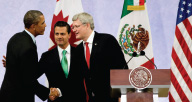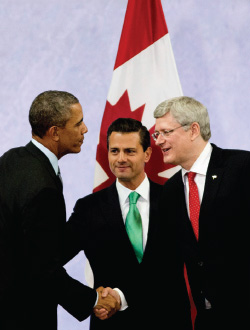A President’s Political Capital

 Pena Nieto has had a whirlwind first year of reforms in all areas of Mexican life. Now he must change the reality on the ground
Pena Nieto has had a whirlwind first year of reforms in all areas of Mexican life. Now he must change the reality on the ground
In his first year as president, Enrique Pena Nieto expended much of his political capital to push through an impressive number of ‘structural reforms.’ In 2013, the Mexican Congress passed a constitutional reform that will allow the private sector to participate in the national oil, gas and electricity markets. It also passed a fiscal reform package, an education reform bill, a telecommunications reform bill, a finance reform bill, an antitrust reform bill, and a political and electoral reform package. The government having had the political acumen to convince the main opposition parties – the PAN and PRD – to support these reforms, the totality of Pena Nieto’s reform push would appear to be a great achievement after nearly two decades of legislative gridlock.
And yet these reforms are, on their own, highly unlikely to increase economic growth or produce a safer and more politically stable Mexico. While the Pena Nieto government has been successful in selling the reforms – within and especially outside of the country – far more is needed for the social and economic advancement of Mexican society and the Mexican state. Here are some of the most urgent issues that must be addressed.
Quality of the reforms. Public opinion and academic specialists have been highly critical of the fiscal and political reforms in particular. The fiscal reform increased federal marginal corporate income tax rates, changed the way in which business depreciation and losses and profits are calculated and, among many other things, introduced a special tax on sodas and high-fat food. However, the reform did not broaden the tax base or give any incentive to ‘micro’ firms and small firms to abandon the informality at the heart of Mexican business culture. Consider also the obesity tax: few believe that a tax alone will credibly tackle this major Mexican health problem, given that obesity has multiple causes, and given that a large proportion of food in Mexico is sold in informal markets. Although it is too early to assess the impact of these changes, some private firms have already announced withdrawals of investment on the argument that the new tax system has diminished their expected rate of return. Consumption may also fall, since disposable income will diminish – especially for the middle and upper middle classes.
The political reforms, for their part, have led to the creation of a body of confusing rules that, among other things, grant the new federal institute for the organization of federal elections (Instituto Nacional Electoral, or INE) powers to remove control of state and local elections from the state electoral institutes. There being little clarity about when exactly the INE can so act, it is easy to foresee significant conflict among the political parties and candidates in state elections, challenging decisions of the INE as circumstances and interests warrant.
Secondary Laws. The success of the reforms will – to be sure – ultimately depend on details. For now, critical details are lacking for the energy, telecommunications and antitrust reforms. For example, the energy reform bill only changed a few sentences in the Constitution, while more substantive changes will be settled through specific or secondary laws. The certainty and clarity of these rules will define how the private sector will participate, and with what intensity of investment.
Implementation. Mexico is a country that excels in creating laws that are simply not followed. Consider events surrounding the new education law. For most of last year, teachers in the CNTE, a teachers’ union that opposes the law, suspended classes in several states – for starters, in Oaxaca, Michoacan and Mexico City – leaving thousands of children out of school for as long as three months. Most of these teachers faced no consequences in respect of their job status or pay. And in January of this year, the minister of education announced the cancellation of ENLACE, a standardized test for all Mexican students up to grade nine. These two episodes patently contradict the overall objectives of the government’s education reform – to wit, the evaluation of student and teacher performance, and the introduction of rewards and sanctions for the actions of the various players in Mexico’s educational system.
Public spending. Structural reforms may well improve conditions for economic growth, but to sustain such growth over the medium and long term, public spending will need to be more efficient. Billions of pesos are spent annually on social programmes with little measurable impact on the welfare of Mexicans. Spending on infrastructure fails to pass any credible cost-benefit analysis. Of course, there is considerable anecdotal evidence of waste in public resources – federally, as well as at the state and municipal levels – but we can also rely on programme evaluations conducted by the National Council for the Evaluation of Social Development Policy (CONEVAL) and analysis done by serious Mexican think tanks, including Mexico Evalua and Fundar.
Crime. Security remains a major concern for all Mexicans. Pena Nieto’s two initial policies on crime involved diminishing the presence of crime-related news in the media, and improving cooperation between the federal, state and local authorities. One year later, however, public perceptions of Mexico’s crime rates have not improved. Although homicides have declined, extortion and kidnappings are on the rise. The capture of Joaquin “El Chapo” Guzman, the country’s most wanted drug baron, is a major coup, but is not in itself expected to dramatically reduce the aggregate level of drug-related violence.
Federalism. Another issue that has received little attention is the role of Mexico’s 31 states (and the Federal District) and more than 2,000 municipal governments in the future of Mexican governance. Over the last 15 years, state governors have gained considerable economic and political power. These changes have not, in the net, issued in better public policy. On the contrary, with fewer checks and balances than at the federal level, state governments have been responsible for some of the most notable and widely reported cases of financial mismanagement and corruption. The response from the centre has been to establish more public expenditure controls and to remove some administrative functions – such as teachers’ payroll – from the states. Such public spending controls are not new. Over the medium to long term, however, given that Mexico is a big and heterogeneous country, what is really needed is a new design for Mexican federalism in toto – a design that incentivizes state and local authorities to generate innovative and sound public policies. This new design must be based on two principal elements: a clear delineation of the responsibilities of each level of government (federal, state and municipal), and expanded capacity for states to collect taxes (something that does not require any constitutional changes, but only changes to taxation laws). The taxation reform would reduce the states’ dependence on federal transfers.
Basic public services may not, for purposes of political optics, generate the same excitement as structural reforms. However, an efficient public transportation system, readily available drinking water, a stable urban development plan, and an efficient local judicial system are crucial factors in reducing crime. And, of course, these are among the first things that entrepreneurs consider when deciding where to invest. As most of these basic services fall into state areas of constitutional competence, it seems manifest that Mexico’s states need to be empowered and capacitated to succeed in delivering them.
Pena Nieto’s recent appearance on the cover of Time magazine is good news: Mexico is much more than its crime indicators. Still, after a magnificent legislative push in Year One, there is little room for complacency. What next, then? The new administration must recognize that it needs to monitor all areas of government – horizontally across the federal ministries, and vertically into the states and municipalities. Feedback loops from the ground back to the centre must be improved. And the centre must carefully evaluate and assess the effects of its reforms and have the political courage to modify these, as the evidence requires. It must be prepared to discuss the future of Mexican federalism.
The economic recovery may be slower than predicted: in 2013, the Mexican economy grew 1.1 percent, as against original forecasts of over three percent. The consumer confidence index is decreasing. Crime rates are still very high; internationally, they are perceived to be higher still. Reality may soon bite if Pena Nieto does not quickly move beyond structural reforms, and beyond Mexico City, to address the complex and crooked timber of the Mexican condition.
César Velázquez Guadarrama is a professor in the Department of Economics, Universidad Iberoamericana, in Mexico City.











